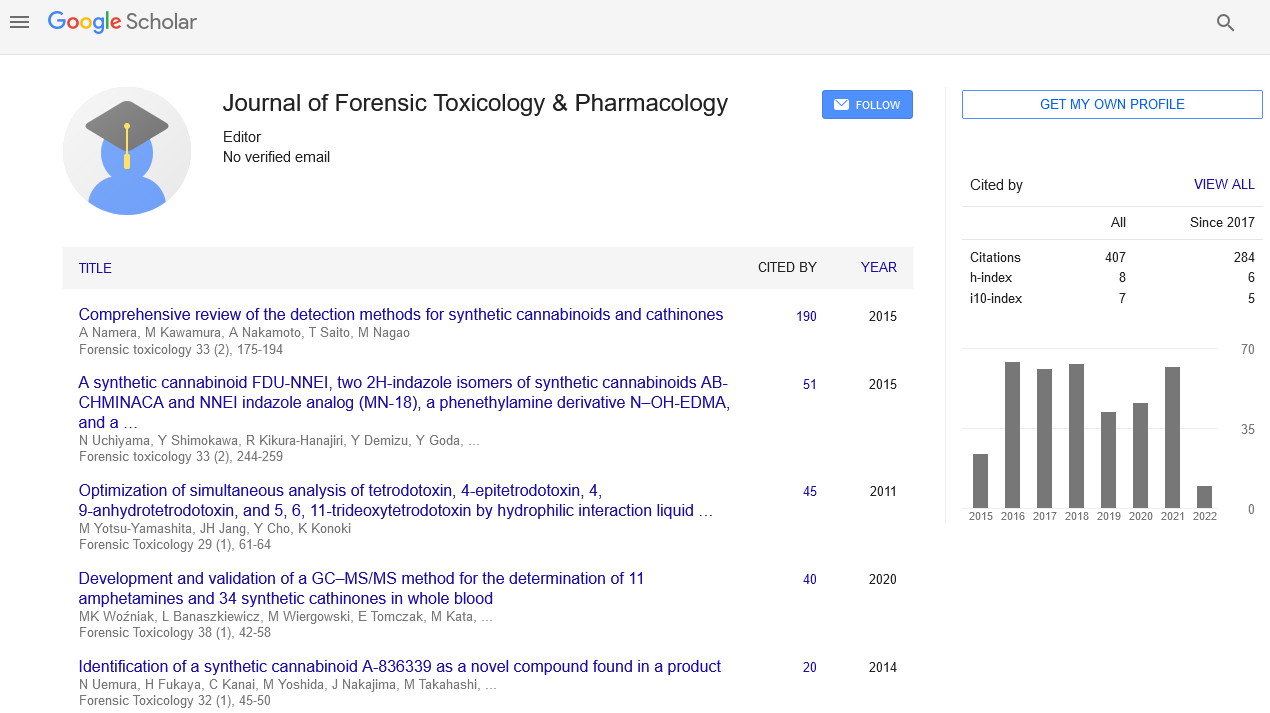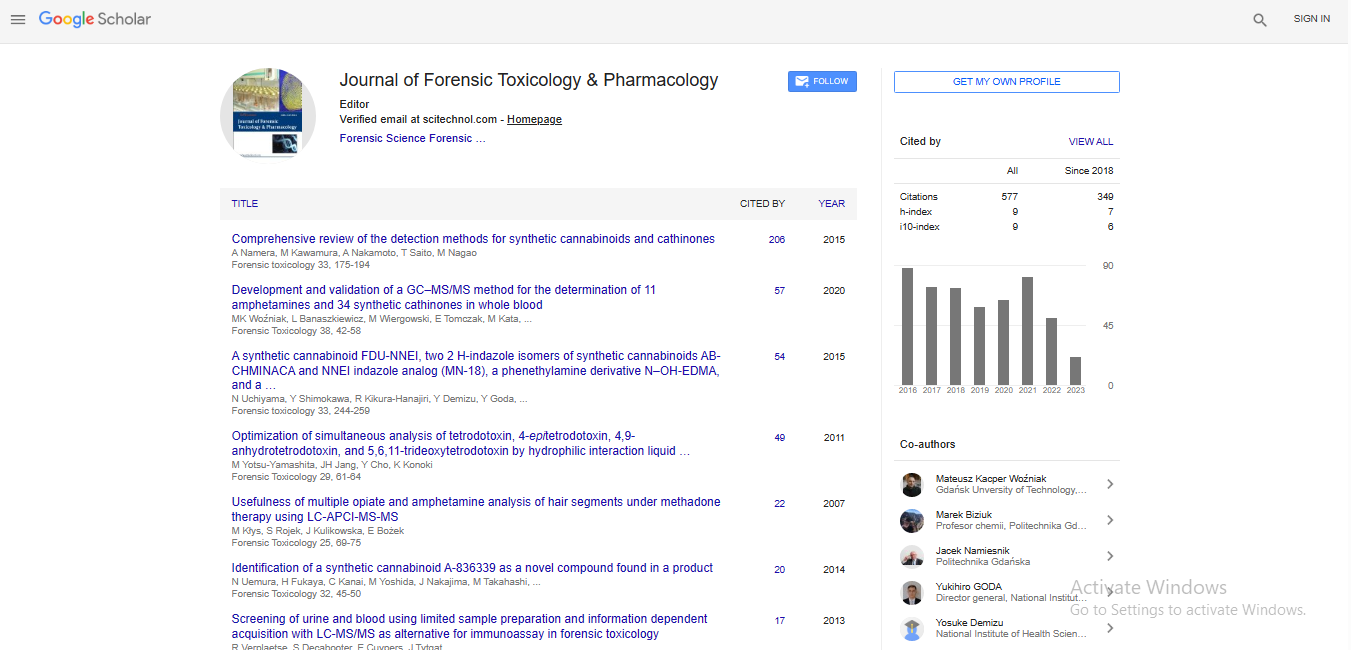Opinion Article, J Forensic Toxicol Pharmacol Vol: 13 Issue: 4
Legal Intoxication Levels: Insights from Forensic Toxicology
Hallmann Treder*
1Department of Forensic Medicine, Nagoya City University Graduate of School Medical Sciences, Nagoya, Japan
*Corresponding Author: Hallmann Treder,
Department of Forensic Medicine,
Nagoya City University Graduate of School Medical Sciences, Nagoya, Japan
E-mail: trederhallmann@gmail.com
Received date: 26 November, 2024, Manuscript No. JFTP-24-156278;
Editor assigned date: 28 November, 2024, PreQC No. JFTP-24-156278 (PQ);
Reviewed date: 12 December, 2024, QC No JFTP-24-156278
Revised date: 19 December, 2024, Manuscript No. JFTP-24-156278 (R);
Published date: 26 December, 2024, DOI: 10.4172/JFTP.1000207.0
Citation: Treder H (2024) Legal Intoxication Levels: Analysis from Forensic Toxicology. J Forensic Toxicol Pharmacol 13:4.
Description
Legal intoxication levels play a pivotal role in ensuring public safety and maintaining law and order. Defined as the concentration of alcohol or drugs in a person's system that impairs their ability to perform tasks safely, these thresholds are determined through rigorous scientific research and form the basis of numerous legal frameworks worldwide. Forensic toxicology provides the analytical backbone for determining intoxication levels and understanding their implications in various legal and public health contexts.
Blood Alcohol Concentration (BAC) is the most commonly used metric for defining legal intoxication levels, particularly in cases of alcohol-impaired driving. In many countries, the legal BAC limit for drivers is set at 0.08%, although stricter limits, such as 0.05% or even zero tolerance, are enforced in some regions. This threshold is based on extensive studies correlating BAC levels with impaired psychomotor skills, reaction times and decision-making abilities. Forensic toxicologists utilize breathalyzers, blood tests and urine analyses to measure BAC accurately, ensuring reliable evidence in legal proceedings.
The legal limits for drugs, however, present more complexity due to the diverse nature of substances and their varying effects on individuals. Unlike alcohol, which has relatively consistent pharmacokinetics, drugs such as cannabis, opioids and stimulants exhibit highly variable metabolism and impairment profiles. To address this challenge, forensic toxicologists often rely on natural limits or zero-tolerance policies. Natural limits specify a concentration of the drug or its metabolites in biological samples, such as blood or saliva, beyond which a person is considered legally impaired. Zero-tolerance policies, on the other hand, prohibit the presence of any detectable level of certain drugs, reflecting a precautionary approach to public safety.
Emerging synthetic drugs and designer substances pose additional challenges in defining legal intoxication levels. These substances often lack established impairment thresholds, making it difficult to correlate concentration levels with functional deficits. In such cases, forensic toxicologists may utilize behavioral assessments, field sobriety tests and advanced analytical techniques to provide a comprehensive evaluation of impairment. The development of standardized protocols and reference materials for these substances is an ongoing effort in the field.
Legal intoxication levels are not limited to driving-related cases; they also play an important role in workplace safety, criminal investigations and public health initiatives. In occupational settings, drug and alcohol testing programs aim to prevent workplace accidents and ensure a safe environment. Forensic toxicologists analyze biological samples to detect substance use and evaluate compliance with organizational policies. Legal thresholds for workplace intoxication are often aligned with those for driving, but specific industries, such as aviation and transportation, may enforce stricter limits due to the higher stakes involved.
In criminal investigations, establishing intoxication levels can provide difficult evidence in cases such as assault, homicide and sexual offenses. Forensic toxicologists analyze post-mortem samples to determine whether intoxication contributed to the events leading to death. These analyses often involve complex interpretations of toxicological findings, taking into account factors such as tolerance, drug interactions and post-mortem redistribution. Accurate determination of intoxication levels can significantly impact the outcome of legal proceedings, influencing judgments and sentencing.
Public health campaigns also benefit from analysis into legal intoxication levels. Educational initiatives aimed at reducing alcohol and drug-related incidents often emphasize the importance of understanding impairment thresholds and the risks associated with exceeding them. Forensic toxicologists contribute to these efforts by providing empirical data on the effects of substances and advocating for evidence-based policies to minimize harm.
Advances in analytical technologies continue to enhance the accuracy and efficiency of determining legal intoxication levels. High- Resolution Mass Spectrometry (HRMS), immunoassays and point-ofcare testing devices enable rapid and precise analyses, even in challenging field conditions. These tools support law enforcement agencies, medical professionals and forensic laboratories in their efforts to uphold legal standards and ensure justice. Legal intoxication levels represent a difficult intersection of science, law and public safety. Forensic toxicology plays an indispensable role in defining and enforcing these thresholds, enhancing advanced analytical techniques to provide reliable evidence and analysis. As new substances and societal challenges emerge, ongoing research and innovation in forensic toxicology will be essential to maintaining the relevance and effectiveness of legal intoxication standards.
 Spanish
Spanish  Chinese
Chinese  Russian
Russian  German
German  French
French  Japanese
Japanese  Portuguese
Portuguese  Hindi
Hindi 
